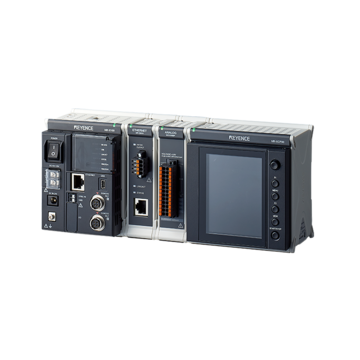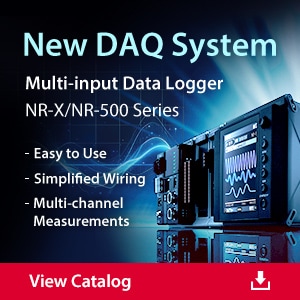Data Acquisition (DAQ)
Voltage Measurement
-
Tags:
- Data Acquisition , Voltage
This section defines voltage and uses waveform screens to provide an easy-to-understand explanation of a key point in selecting the sampling cycle. It also introduces how to set triggers to collect target waveforms and how to select instruments suitable for specific purposes and applications.
We’re here to provide you with more details.
Reach out today!

Measurement Improvement
- What Is Voltage?
- How to Measure Voltage
- Effect of Inter-channel Insulation
- Triggers
Analysis Improvement
- How to Select a Data Logger for Voltage Measurement
- Key Points in Selecting the Sampling Cycle
- Thinking about Resolution and Accuracy
Applications and Examples
- Applications and Examples of Analog (Current/Voltage) Measurement
Discover more about this product.
Click here to book your demo.

What is Voltage?
Electrical voltage is referred to as a difference in the electric potential or electromotive force between two points. It’s a fundamental concept in electricity, and for those who aren’t familiar with the field, the voltage can be thought of as a force that drives the flow of electrons—the electric current—from the point of higher electric potential toward the point of lower potential or ground.
Think of voltage as a pressure in the water pipe; just as water pressure pushes water through a pipe, voltage pushes the electric current through an electrical circuit. In simplest terms, voltage is a measure of potential energy per unit charge between two points within an electric field.
The voltage causes current to flow, and the higher the voltage, the more potential energy can be pushed through the circuit. Here’s an example. Currents above 30 mA are potentially lethal for humans, and 3 A (3,000 mA) at 110 V is considered exceptionally dangerous.
However, 3,000 mA at 5 V isn’t nearly as dangerous because 5 V isn’t typically enough to overcome the natural electrical resistance of the human body and is less likely to cause damage or fatality.
Please note that we still highly advise against touching any electrical or electronic circuits with your bare hands, regardless of current and voltage levels. With that said, for measuring voltage, it’s important to differentiate between direct and alternating voltage.
Direct Voltage
Direct voltage, often labeled as (DC), is constant and unidirectional. This means that the current flows in one direction only. This type of voltage is found in batteries, solar cells, and DC power supply units, and it’s most commonly used in electronics, LED lights, and EVs.
AC Voltage
In contrast, AC voltage changes direction periodically (50 to 60 times per second, depending on where you live) and can also vary in magnitude. AC voltage is typically supplied to homes and businesses for general power use. It’s the type of voltage you get from a standard wall outlet. Now, let’s discuss voltage measurement.
Curious about our pricing?
Click here to find out more.

AC Voltage Measurement vs DC Voltage Measurement
Voltage measurement is typically done with a voltmeter, though multimeters are much more common nowadays. When measuring DC voltage between two points, connect your multimeter or measuring device’s probes to the appropriate points.
The device will measure a difference in potential between two points or measure voltage levels relative to the reference point. Assuming you’re measuring 5 V, the measuring device, such as a data logger or data acquisition system, will either output 5 V or -5 V. If you get a reading of -5 V, that means that the polarity of your probes doesn’t correspond to the polarity of the points you’re measuring.
Switching the probe placement solves this problem and indicates which point is 0 V (ground) and which carries a charge, in this case, 5 V.
AC Voltage Measurement
Measuring AC voltage is somewhat different, as it continuously changes polarity and direction. To effectively measure AV voltage, the measuring device has to compensate for these changes. As such, it usually measures the Root Mean Square value, which is an effective value of AC voltage comparable to a DC voltage that would deliver the same power.
Due to its alternating nature and the built-in compensation within the measurement device, probe polarity doesn’t matter when it comes to voltage measurements in AC circuits. It’s also important to note that measuring AC voltage can’t be done with devices designed to measure DC voltage and vice versa. Fortunately, modern devices measure both types.
Ready to take your voltage measurements to the next level? Check out KEYENCE's line of data loggers and data acquisition systems today!
Contact us to learn more about how our advanced technology can help take your business to the next level.
Contact Us

![Introductory Guide to Voltage Measurement [Basic Knowledge of Voltage Measurement]](/img/asset/AS_118629_L.jpg)

